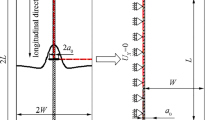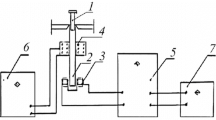Abstract
Stress intensity factors due to surface crack propagation were analysed by using the influence function method and inherent strain analysis of the residual stress fields caused by welding. The initial residual stress in a plate with a welded butt joint was calculated by using inherent strain analysis, and the redistribution of residual stress and the stress intensity factor due to crack propagation were analysed as changes in the structure’s shape. The stress intensity factor was also calculated by using an influence function database. The stress intensity factor in the residual stress fields due to crack propagation obtained by using inherent strain analysis completely agreed with that obtained by using the influence function method. The results of the crack propagation analysis were compared with the experimental results of a fatigue test. It was validated that both the inherent strain analysis and the influence function method were efficient for analysing stress intensity factors in residual stress fields caused by welding.
Similar content being viewed by others
References
Mochizuki M., Hattori T., Nakakado K.: Residual stress reduction and fatigue strength improvement by controlling welding pass sequences, Transactions of the American Society of Mechanical Engineers, Journal of Engineering Materials and Technology, 2000, Vol. 122, No. 1, pp. 108–112.
Mochizuki M., Hayashi M., Hattori T.: Residual stress distribution depending on welding sequence in multi-pass welded joints with X-shaped groove, Transactions of the American Society of Mechanical Engineers, Journal of Pressure Vessel Technology, 2000, Vol. 122, No. 1, pp. 27–32.
Glinka G.: Effect of residual stress on fatigue crack growth in steel weldments under constant and variable amplitude loads, fracture mechanics, ASTM STP, 1979, Vol.677, pp. 198–214.
Parker A.P.: Stress intensity factors, crack profiles, and fatigue crack growth rates in residual stress fields, residual stress effects in fatigue, ASTM STP, 1982, Vol.776, pp. 13–31.
Nelson D.V.: Effects of residual stress on fatigue crack propagation, residual stress effects in fatigue, ASTM STP, 1982, Vol.776, pp. 172–194.
Honda K., Torii T., Toi N., Motoki K.: Effect of residual stress field on fatigue crack growth in cracked plates, Journal of the Society of Materials Science, Japan, 1982, Vol. 31, No. 348, pp. 908–914 (in Japanese).
Kobayashi H., Todoroki A.: Effect of weld-induced residual stress on fatigue crack growth in compact specimen, Journal of the Society of Materials Science, Japan, 1986, Vol. 35, No. 391, pp. 401–406 (in Japanese).
Ohji K., Kubo S., Tsuji M., Ogawa H., Sakurada K.: Methods of predicting fatigue crack growth lives in residual stress fields, Transactions of the Japan Society of Mechanical Engineers, 1987, Vol. 53, No. 492, A, pp. 1516–1524 (in Japanese).
Mukai Y., Murata M., Kim E.J.: A proposal for stress intensity factor range calculation method by partial opening model of fatigue crack under weld residual stress field and prediction of the crack propagation behavior, Quarterly Journal of the Japan Welding Society, 1987, Vol. 5, pp. 269–272 (in Japanese).
Jono M., Sugeta A.: Effect of residual stress on fatigue crack growth rate and crack closure under varying loadings, Journal of the Society of Materials Science, Japan, 1987, Vol. 36, No. 409, pp. 1071–1076 (in Japanese).
Kitsunai Y., Kobayashi H., Narumoto A., Ishizuka T., Iida K., Yoshihisa E.: Effect of residual stress on fatigue crack growth behavior of STS42 steel weldments, Journal of the Society of Materials Science, Japan, 1987, Vol. 36, No. 409, pp. 1077–1083 (in Japanese).
Todoroki A., Kobayashi H.: Prediction of fatigue crack growth rate in residual stress field (Application of Superposition Technique), Transactions of the Japan Society of Mechanical Engineers, 1988, Vol. 54, No. 497, A, pp. 30–37 (in Japanese).
Todoroki A., Kobayashi H., Nakamura H.: Prediction of fatigue crack growth rate in residual stress field (Consideration of partial crack surface contact), Transactions of the Japan Society of Mechanical Engineers, 1988, Vol. 54, No. 498, A, pp. 205–211 (in Japanese).
Stacey A., Webster G.A.: Influence of residual stress on fatigue crack growth in thick-walled cylinders, Analytical and experimental methods for residual stress effects in fatigue, ASTM STP, 1988, Vol. 1004, pp. 107–121.
Torii T., Honda K., Hisakawa I.: Surface fatigue crack propagation behavior in residual stress fields distributed along the thickness of plates (On fatigue crack propagation rate toward the depth of surface precracks), Transactions of the Japan Society of Mechanical Engineers, 1990, Vol. 56, No. 524, A, pp. 745–751 (in Japanese).
Beghini M., Bertini L., Vitale E.: Fatigue crack growth in residual stress fields, experimental results and modeling, Fatigue and Fracture Engineering of Materials and Structures, 1994, Vol. 17, pp. 1433–1444.
Toyosada M., Niwa, T.: Fatigue crack propagation behavior in the field of residual stress distribution — Study of fatigue crack propagation behavior based upon RPG Load (7th Report), Journal of the Society of Naval Architects of Japan, 1995, Vol. 178, pp. 505–511 (in Japanese).
Buchalet C.B., Bamford W.H.: Stress intensity factor solutions for continuous surface flaws in reactor pressure vessels, Mechanics of crack growth, ASTM STP, 1976, Vol. 590, pp. 385–402.
Yagawa G., Ichinomiya M., Ando Y.: Theory and experiment of thermal impact fracture from crack (Application of stress intensity factor analysis based on discrete error), Transactions of the Japan Society of Mechanical Engineers, 1979, Vol. 45, No. 395, A, pp. 734–742 (in Japanese).
McGowan J.J., Raymund M.: Stress intensity factor solutions for internal longitudinal semi-elliptical surface flaws in a cylinder under arbitrary loadings, Fracture mechanics, ASTM STP, 1979, Vol. 677, pp. 365–380.
Shiratori M., Miyoshi T., Tanigawa K.: Analysis of stress intensity factors for surface cracks subjected to arbitrarily distributed surface stresses, Transactions of the Japan Society of Mechanical Engineers, 1985, Vol. 51, No. 467, A, pp. 1828–1835 (in Japanese).
Shiratori M., Miyoshi T., Tanigawa K.: Analysis of stress intensity factors for surface cracks subjected to arbitrarily distributed surface stresses (2nd Report, a Analysis and application of influence coefficients for flat plates with a semielliptical surface crack), Transactions of the Japan Society of Mechanical Engineers, 1986, Vol. 52, No. 474, A, pp. 390–398 (in Japanese).
Shiratori M., Miyoshi T., Sakai Y., Zhang G.: Analysis of stress intensity factors for surface cracks subjected to arbitrarily distributed surface stresses (3rd Report, Analysis and application of influence coefficients for round bars with a semielliptical surface crack), Transactions of the Japan Society of Mechanical Engineers, 1987, Vol. 53, No. 488, A, pp. 779–785 (in Japanese).
Shiratori M., Miyoshi T., Sakai Y.: Analysis of stress intensity factors for surface cracks subjected to arbitrarily distributed surface stresses (4th Report, Application of influence coefficients for the cracks originating at the notches and welding joints), Transactions of the Japan Society of Mechanical Engineers, 1987, Vol. 53, No. 492, A, pp. 1651–1657 (in Japanese).
Shiratori M., Yu Q., Nishijima A.: Analysis of stress intensity factors for cracked members under displacement constraint, Proceedings of the National Meeting of the Japan Society of Mechanical Engineers, Vol. 4, No. 930-9, 1993–3, pp. 56–58 (in Japanese).
Shiratori M., Yu Q., Nishijima A., Watanabe K.: Analysis of stress intensity factors for surface cracks in thermal stress field, Proceedings of the 6th Computational Mechanics Conference of the Japan Society of Mechanical Engineers, No. 930-71, 1993–11, pp. 227–228 (in Japanese).
Watanabe T.: Fracture mechanics — From Theory and analysis to engineering application, Yagawa G. Edited, Baifu-kan, 1988, pp. 229–254 (in Japanese).
Mochizuki M., Hayashi M., Hattori T.: Numerical analysis of welding residual stress and its verification using neutron diffraction measurement, Transactions of the American Society of Mechanical Engineers, Journal of Engineering Materials and Technology, 2000, Vol. 122, No. 1, pp. 98–103.
Okamura H.: Introduction to linear fracture mechanics, Baifu-kan, 1976, pp. 36–43 (in Japanese).
Mukai Y., Nishimura A., Kim E.J.: Redistribution of residual stress caused by crack propagation initially through residual tensile stress field, Quarterly Journal of the Japan Welding Society, 1986, Vol. 4, pp. 154–159 (in Japanese).
Mukai Y., Nishimura A., Kim E.J.: Redistribution of residual stress caused by crack propagation initially through residual compressive stress field, Quarterly Journal of the Japan Welding Society, 1986, Vol. 4, pp. 634–639 (in Japanese).
Honda K., Torii T., Fei Z.: Analysis and measurements of residual-stress redistribution due to material removal in a plate, Journal of the Society of Materials Science, Japan, 1988, Vol. 37, No. 415, pp. 391–397 (in Japanese).
Honda K., Torii T., Fei Z.: Residual-stress redistribution and deformation due to material removal during the formation of a full-depth hole in a plate, Transactions of the Japan Society of Mechanical Engineers, 1989, Vol. 55, No. 512, A, pp. 879–886 (in Japanese).
Sato T., Kobayashi H., Arai Y.: Finite element analysis of residual stresses of ceramics/metal joints (Effect of cutting on redistribution of residual stresses), Transactions of the Japan Society of Mechanical Engineers, 1991, Vol. 57, No. 540, A, pp. 1801–1807 (in Japanese).
Mochizuki M., Hayashi M., Hattori T.: Residual stress analysis by simplified inherent strain at welded pipe junctures in a pressure vessel, Transactions of the American Society of Mechanical Engineers, Journal of Pressure Vessel Technology, 1999, Vol. 121, No. 4, pp. 353–357.
Mochizuki M., Hayashi M., Hattori T.: Comparison of five evaluation methods of residual stress in a welded pipe joint, JSME International Journal (Series A), 1999, Vol. 42, No. 1, pp. 104–110.
Miyazaki K., Enomoto K., Hayashi M., Kanno S.: Evaluation of surface fatigue crack growth using stress intensity factor with a plastic zone correction, Proceedings of the 72nd Spring Annual Meeting of the Japan Society of Mechanical Engineers, 1995, Vol. 2, No. 95–1, pp. 344–345 (in Japanese).
The Society of Materials Science, Japan, Edited, Databook of Fatigue Crack Growth Rates of Metallic Materials, The Society of Materials Science, Japan, 1983, Vol. 1v, pp. 22–23.
Iida K., Kho Y.: Empirical expressions of surface fatigue crack shape, Journal of the Society of Naval Architects of Japan, 1980, Vol.147, pp. 211–218 (in Japanese).
Mochizuki M., Hayashi M., Nakagawa M., Tada N., Shimizu S.: A simplified analysis of residual stress at welded joints between plate and penetrating pipe, JSME International Journal (Series A), 1997, Vol. 40, No. 1, pp. 8–14.
Author information
Authors and Affiliations
Rights and permissions
About this article
Cite this article
Mochizuki, M., Miyazaki, K. Surface Crack Propagation Analysis under Residual Stress Field. Weld World 50, 38–45 (2006). https://doi.org/10.1007/BF03266522
Published:
Issue Date:
DOI: https://doi.org/10.1007/BF03266522




